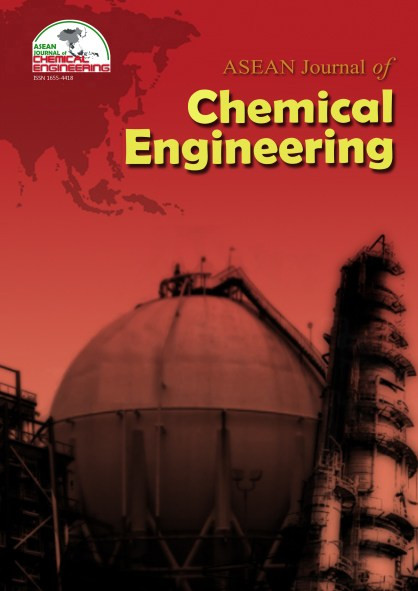Modification of Natural Zeolite as a Catalystfor Steam Reforming of Toluene
Abstract
A catalyst for tar cracking has been prepared successfully from natural zeolites using ion exchange with NH4NO3, and acid leaching with HNO3 solution for removing impurities and increasing pore volume. The activity of the modified zeolite was tested using toluene as a tar model compound. Tar conversion of about 54% was achieved in catalytic steam reforming at a temperature of 750C using 2 gram of catalyst and the gas hourly space velocity about 5040 h-1.
References
2. Buchireddy, P. R., Bricka, R. M., Rodriguez, J. & Holmes, W. (2010). Biomass gasification: catalytic removal of tars over zeolites and nickel supported zeolites. Energy Fuels, 24, 2707-2715.
3. Coll, R., Salvadó, J., Farriol, X. & Montané, D. (2001). Steam reforming model compounds of biomass gasification tars: conversion at different operating conditions and tendency towards coke formation. Fuel Processing Technology, 74, 19-31.
4. Constantinou, D. A. & Efstathiou, A. M. (2009). The steam reforming of phenol over natural calcite materials. Catalysis Today, 143, 17-24.
5. Devi, L., Ptasinski, K. J., Janssen, F. J. J. G., van Paasen, S. V. B., Bergman, P. C. A. & Kiel, J. H. A. (2005). Catalytic decomposition of biomass tars: use of dolomite and untreated olivine. Renewable Energy, 30, 565-587.
6. Fredrik, L., Nicolas, B., Martin, S. & Henrik, T. (2013). Ilmenite and Nickel as Catalysts for Upgrading of Raw Gas Derived from Biomass Gasification. Energy Fuels, 27 997–1007.
7. Heo, D. H., Lee, R., Hwang, J. H. & Sohn, J. M. (2016). The effect of addition of Ca, K and Mn over Ni- based catalyst on steam reforming of toluene as model tar compound. Catalysis Today, 265, 95-102.
8. Kadarwati, S., Rahmawati, F., Rahayu, P. E., wahyuni, S. & Supardi, K. I. (2013). Kinetics and Mechanism of Ni/Zeolite- Catalyzed Hydrocracking of Palm Oil Into Bio-Fuel. Indo. J. Chem, 13, 77-85.
9. Kuhn, J. N., Zhao, Z., Felix, L. G., Slimane, R. B., Choi, C. W. & Ozkan, U. S. (2008). Olivine catalysts for methane- and tar-steam reforming. Applied Catalysis B: Environmental, 81, 14-26.
10. Laosiripojana, N., Sutthisripok, W., Charojrochkul, S. & Assabumrungrat, S. (2014). Development of Ni–Fe bimetallic based catalysts for biomass tar cracking/reforming: Effects of catalyst support and co-fed reactants on tar conversion characteristics. Fuel Processing Technology, 127, 26-32.
11. Nasser, G. A., Kurniawan, T., Tago, T., Bakare, I. A., Taniguchi, T., Nakasaka, Y., Masuda, T. & Muraza, O. (2016). Cracking of n-hexane over hierarchical MOR zeolites derived from natural minerals. Journal of the Taiwan Institute of Chemical Engineers, 61, 20-25.
12. Schmidt, S., Giesa, S., Drochner, A. & Vogel, H. (2011). Catalytic tar removal from bio syngas—Catalyst development and kinetic studies. Catalysis Today, 175, 442-449.
13. Silaghi, M.-C., Chizallet, C. & Raybaud, P. (2014). Challenges on molecular aspects of dealumination and desilication of zeolites. Microporous and Mesoporous Materials, 191, 82-96.
14. Simell, P. A., Hepola, J. O. & Krause, A. O. I. (1997). Effects of gasification gas components on tar and ammonia decomposition over hot gas cleanup catalysts. Fuel, 76, 1117-1127.
15. Yue, B., Wang, X., Ai, X., Yang, J., Li, L., Lu, X. & Ding, W. (2010). Catalytic reforming of model tar compounds from hot coke oven gas with low steam/carbon ratio over Ni/MgO– Al2O3 catalysts. Fuel Processing Technology, 91, 1098-1104.
16. Zanjanchi, M. A. & Hemmati, M. (2004). Verification of extra-framework aluminum in zeolite L by acetylacetone. Materials Chemistry and Physics, 85, 334-339.
17. Zou, X., Chen, T., Liu, H., Zhang, P., Chen, D. & Zhu, C. (2016). Catalytic cracking of toluene over hematite derived from thermally treated natural limonite. Fuel, 177, 180-189.
Copyright holder for articles is ASEAN Journal of Chemical Engineering. Articles published in ASEAN J. Chem. Eng. are distributed under a Creative Commons Attribution-NonCommercial 4.0 International (CC BY-NC 4.0) license.
Authors agree to transfer all copyright rights in and to the above work to the ASEAN Journal of Chemical Engineering Editorial Board so that the Editorial Board shall have the right to publish the work for non-profit use in any media or form. In return, authors retain: (1) all proprietary rights other than copyright; (2) re-use of all or part of the above paper in their other work; (3) right to reproduce or authorize others to reproduce the above paper for authors’ personal use or for company use if the source and the journal copyright notice is indicated, and if the reproduction is not made for the purpose of sale.



